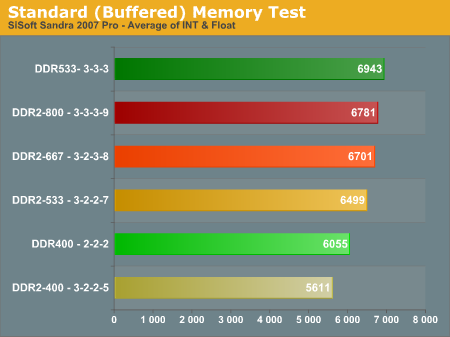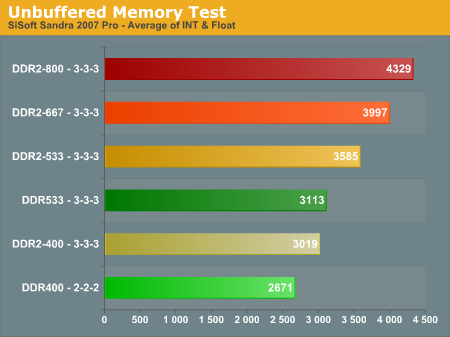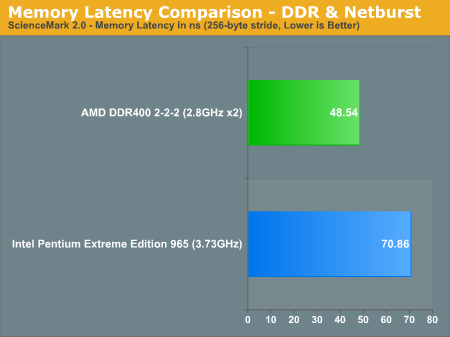DDR/NetBurst Memory Bandwidth and Latency
One of the most talked-about AMD advantages of the last couple of years has been their on-processor memory controller. This has allowed, according to popular theories, the Athlon64 to significantly outperform Intel NetBurst processors. The fact is NetBurst DDR2 bandwidth has recently been similar or wider in bandwidth than Athlon64 - even when the DDR is overclocked. You can see this clearly when we compare Buffered and Unbuffered Bandwidth of a NetBurst 3.46EE to an AMD 4800+ x2(2.4GHz, 2x1MB Cache) running DDR400 2-2-2 and running overclocked memory at DDR533 3-3-3.
The green bars represent DDR memory performance, while the beige to red are increasing DDR2 speed on NetBurst. Light green represents DDR400 2-2-2 while Dark Green is overclocked memory at the same CPU speed, DDR533 at 3-3-3.

In buffered performance, Fast DDR400 is only faster than DDR2-400 and slower than DDR2-533, 667 and 800. Overclocked memory at DDR533 3-3-3 is faster than any of the DDR2 bandwidths on NetBurst.
The Sandra Unbuffered Memory Test, which turns off features that tend to artificially boost performance, is generally a better measure of how memory will behave comparatively in gaming. The same green for DDR applies here.

Without Buffering, DDR400 has the smallest bandwidth of tested memory speeds and timings. Even overclocking to DDR533 allows the DDR to barely beat DDR2-400. DDR2-533, 667, and 800 all have greater Unbuffered bandwidth than the DDR overclocked to 533. NetBurst DDR2 memory bandwidth is generally wider than the bandwidth supplied by DDR memory on Athlon64. Despite the wider bandwidth, the deep pipelines and other inefficiencies in the NetBurst design did not allow the NetBurst processors to outperform Athlon64. Keep this in mind later, when we look at AM2 and Core 2 Duo Memory Bandwidth.
Latency
The other area where AMD has had an advantage over NetBurst DDR2 performance is memory latency, the result of the on-processor memory controller. Comparison of the AMD DDR Memory controller and the Intel DDR2 Memory controller in the Intel chipset shows AMD DDR with latency about 35% lower than Intel NetBurst in Science Mark 2.0.

While memory bandwidth was very similar between AMD and NetBurst, the deep pipes of the NetBurst design still behaved as if they were bandwidth starved. On the other hand the AMD architecture made use of the bandwidth available and the much lower latency to outperform NetBurst across the board.
One of the most talked-about AMD advantages of the last couple of years has been their on-processor memory controller. This has allowed, according to popular theories, the Athlon64 to significantly outperform Intel NetBurst processors. The fact is NetBurst DDR2 bandwidth has recently been similar or wider in bandwidth than Athlon64 - even when the DDR is overclocked. You can see this clearly when we compare Buffered and Unbuffered Bandwidth of a NetBurst 3.46EE to an AMD 4800+ x2(2.4GHz, 2x1MB Cache) running DDR400 2-2-2 and running overclocked memory at DDR533 3-3-3.
The green bars represent DDR memory performance, while the beige to red are increasing DDR2 speed on NetBurst. Light green represents DDR400 2-2-2 while Dark Green is overclocked memory at the same CPU speed, DDR533 at 3-3-3.

In buffered performance, Fast DDR400 is only faster than DDR2-400 and slower than DDR2-533, 667 and 800. Overclocked memory at DDR533 3-3-3 is faster than any of the DDR2 bandwidths on NetBurst.
The Sandra Unbuffered Memory Test, which turns off features that tend to artificially boost performance, is generally a better measure of how memory will behave comparatively in gaming. The same green for DDR applies here.

Without Buffering, DDR400 has the smallest bandwidth of tested memory speeds and timings. Even overclocking to DDR533 allows the DDR to barely beat DDR2-400. DDR2-533, 667, and 800 all have greater Unbuffered bandwidth than the DDR overclocked to 533. NetBurst DDR2 memory bandwidth is generally wider than the bandwidth supplied by DDR memory on Athlon64. Despite the wider bandwidth, the deep pipelines and other inefficiencies in the NetBurst design did not allow the NetBurst processors to outperform Athlon64. Keep this in mind later, when we look at AM2 and Core 2 Duo Memory Bandwidth.
Latency
The other area where AMD has had an advantage over NetBurst DDR2 performance is memory latency, the result of the on-processor memory controller. Comparison of the AMD DDR Memory controller and the Intel DDR2 Memory controller in the Intel chipset shows AMD DDR with latency about 35% lower than Intel NetBurst in Science Mark 2.0.

While memory bandwidth was very similar between AMD and NetBurst, the deep pipes of the NetBurst design still behaved as if they were bandwidth starved. On the other hand the AMD architecture made use of the bandwidth available and the much lower latency to outperform NetBurst across the board.










118 Comments
View All Comments
Calin - Wednesday, July 26, 2006 - link
I wonder if Conroe is losing a part of its bandwidth to the prefetcher. It might be so (the prefetcher is busy bringing things that will be or won't be needed, and discards some of them. Meanwhile, the memory bandwidth usable decreases).defter - Tuesday, July 25, 2006 - link
I don't recall that other benchmarks contained DDR2-400, DDR2-533, DDR2-667, DDR2-800 comparison.Basically, this review shows that if you don't want to pay a big premium for DDR2-800, Conroe is even more attractive. This isn't very suprising, because Conroe's 1066MHz (8.4GB/s) FSB can be saturated by dual-channel DDR2-533 (2x4.2GB/s = 8.4GB/s).
classy - Tuesday, July 25, 2006 - link
The Conroe buying guide was a great article, much like the Anandtech of old. But this review is too much like the recent ones absolutely of little or no value. What was the purpose of this read? We know already know core is faster.....we know already know as it is has been shown numerous times around the net memory scaling. Where is the originality at anymore? Want an example? There is a clear price difference between the two now. If a person goes AMD, they will be able to afford a better graphics card then say someone who goes Core. So why not a comparison along those lines. There is so much more to the puzzle then the same old lets run some benchmarks.bob661 - Tuesday, July 25, 2006 - link
I would like to see more articles on memory and motherboards myself for the Conroe.Wesley Fink - Tuesday, July 25, 2006 - link
From the conclusion : "The deep price cuts announced by AMD yesterday will definitely help. The new numbers indicate AM2 will be very competitive at the low end to low-mid of the processor food chain - a spot they have held in the past and where they have still managed to survive. The low end looks very competitive, and AMD is positioned close enough to mid-range in performance to keep Intel honest. There is no mistaking, however, that Intel Core 2 Duo owns the mid to high-end of the current processor market."OcHungry - Wednesday, July 26, 2006 - link
Now wait a minute- The E6800 costs ~ $1200 (if you find one), the FX62 is $800, which is 50% less. According to your review/benchmarks you propose E6800 is about 20% better performer than FX62. Considering price/performance ratio, FX62 should be the ideal choice for high end users/enthusiasts as far as price/performance is concerned.Am I wrong? This is without considering motherboard and video card limitation(s) of Intel platform. The high end enthusiasts would not run single graphic card or IGP system. Have you figured into price/performance of CPU, Motherboard and video card? Or SLI and Crossfire?
What about 4x4?
AMD is releasing 4x4's on several x2 CPU's (I think other than FX62) that will cost less than $1000. Are you saying a $1200 E6800 is a better performer than a less than $1000 4X4?
wouldn’t a 4x4 make the top end of the enthusiast’s market?
In my country a 4x4 make a stronger candidate for "the new king to be born".
DigitalFreak - Tuesday, July 25, 2006 - link
Give up, Wesley. :-)The AMD fanboys will keep trying to destroy your conclusions, since it doesn't benefit them.
duploxxx - Tuesday, July 25, 2006 - link
why would they, you might call me a fanboy but for sure the statement of wesley is true.the high performanmce market is for now (ehh from the moment you can buy them) back at the intel site... (the low-mid market is for both altough amd has an advantage here on lower price in combination with lower price on mobo's and global availability) the perfromance crown for the e6700 and xe6800and will remain there until amd pulls out something new, even if it is by 4x4... perfromance crown is performance crown... some people just do and buy anything as long as it is the fastest... same with gpu cards.. they'll buy them every month.
drebo - Tuesday, July 25, 2006 - link
If you consider an Athlon64 X2 5000+ or FX-62 "low-mid" tier performance, I suppose you could come to this conclusion.
Fact is, on a dollar-for-dollar basis, AMD still leads in, or atleast matches, performance. If I look at my main processor vendor's future pricing on Core 2 Duo processors(they're not scheduled to get any in until August 18th, by the way) and compare them with Athlon64 X2 processors under the new pricing scheme, this is what it looks like:
Athlon64 X2 3800+ @ $149
Athlon64 X2 4200+ @ $183
Core 2 Duo E6300 @ $199.58
Athlon64 X2 4400+ @ 219.79
Athlon64 X2 4600+ @ 235.00
Core 2 Duo E6400 @ 239.58
Athlon64 X2 4800+ @ 279.74
Athlon64 X2 5000+ @ 294.74
Core 2 Duo E6600 @ 334.32
Core 2 Duo E6700 @ 553.26
Athlon64 FX-60/62 @ 811.00
Core 2 Duo X6800 @ 1021.68
Now, that gives us a few pairing(on which Athlon64 X2 processors always come out below) by which to compare: 4200+ vs E6300, 4600+ vs E6400, 5000+ vs E6600. Now, according to Anandtech's own Conroe vs Athlon64 benchmarks, the Athlon64 meets or exceeds the corresponding Conroe processor in probably 90% of the non-synthetic benchmarks. THIS is the important thing. I can take an FX-60 and just as easily compare it to a Pentium D 930 and say that the FX-60 is better, discounting the fact that the FX-60 is nearly 4x the cost.
The same is true here, and I've seen countless review sites doing it. Yes, the E6700 and X6800 processors outperform anything AMD has to offer, but they also cost more than anything AMD has to offer. AMD no longer has a processor at the $1000 price point, and down the line, AMD processors consistently cost less than Core 2 Duo processors they perform just as well against. It is this that is the important thing and it is this than none of the review sites or press has addressed. AMD is still quite competative dollar-for-dollar, particularly when you factor in motherboard cost.
coldpower27 - Tuesday, July 25, 2006 - link
Try meets or is slightly behind. AMD processors rarely "exceeds" in real world applications in the slightest.an E6600 is faster then the 5000+
an E6400 is faster then the 4600+
and E6300 is faster then the 4200+
as has been shown by Anandtech.